Lucknow: In a bright playroom, children jump up and down in a ball pit, squealing in glee. Outside, teenagers splash around in the pool, their voices cutting through the music blaring in the background. A waiter slices fresh watermelon and papayas for the post-swim snack. This could be a posh resort in Delhi. Except, it’s the City Montessori School in Rajajipuram, Lucknow.
With 60,000 students across 21 campuses, the 65-year-old CMS chain of schools has clawed its way to the top to become an integral part of the city, on par with legacy Lucknow schools like La Martiniere and Loreto Convent.
Today, Lucknow is known for tunday kebab, chikankari — and CMS.
What began with just five students is now recognised by the Guinness Book of World Records as the world’s largest school. CMS is to Lucknow what DPS is to Delhi. And like the hydra-headed DPS, the branch attended makes all the difference.
Parents send their children here to become future IAS and IPS officers. It’s got political patronage, popularity, and prestige. Several former students have gone on to become political leaders, ambassadors, and IAS–IPS officers. The school’s homepage has a carefully curated list of such alumni: Prakash Gupta, former joint secretary (Summits) in the Ministry of External Affairs, IPS officer Gyaneshwar Singh, former deputy general of the Narcotics Control Bureau, BJP MP Sudhanshu Trivedi. Then there are singer and composer Lucky Ali, actor Celina Jaitly, and cricketer Suresh Raina.
CMS has put Lucknow not only on national but on the international map
–Uttar Pradesh Education Minister Sandeep Singh
“We are making world leaders,” said Geeta Gandhi Kingdon, who stepped in as managing director this year after the death of her father Jagdish Gandhi, the co-founder of the chain. “CMS students have a larger–than–life approach. They intend to create a difference in the world — that’s also our USP.”
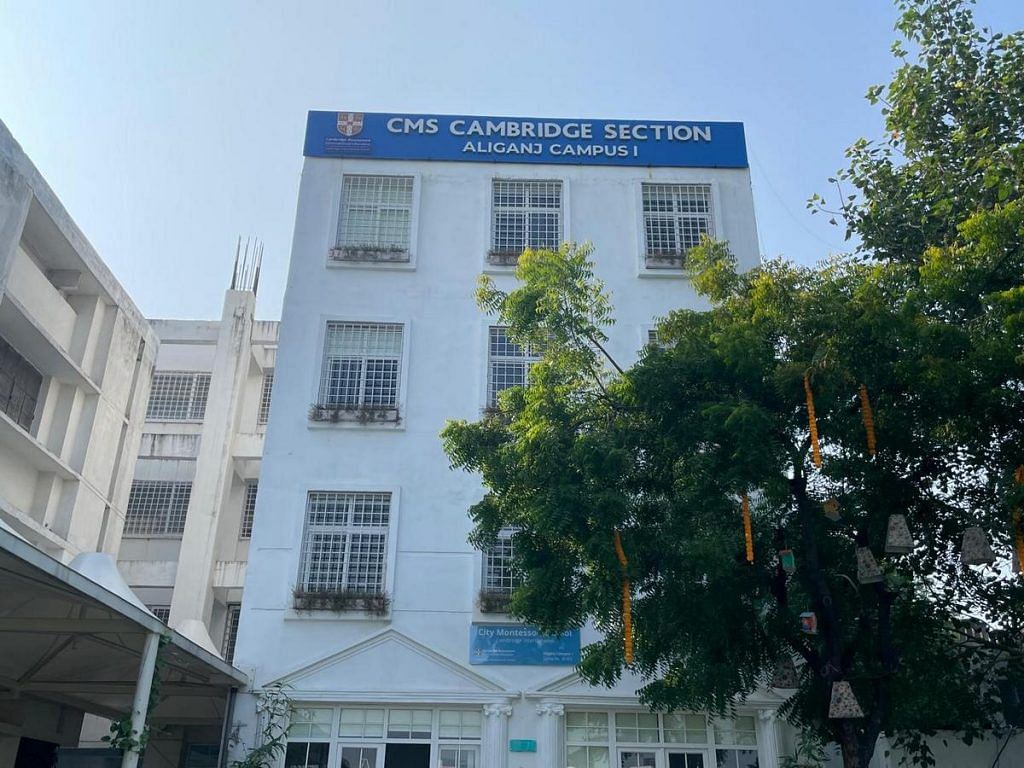
Kingdon has plans to modernise, digitise, and introduce data-driven policies to take the school moving forward. But some core values haven’t changed. Everyone in CMS, from students to teachers, still greet each other with ‘Jai Jagat’ or victory of the world, a phrase coined by philosopher Vinoba Bhave.
And Lucknow’s parents are lining up. Some enroll their children years in advance. And, they don’t take no for an answer.
“There is cut-throat competition. I had to tap into my network and make some calls just to get a seat for my child,” said Pankaj Srivastava, who came to pick up his 10-year-old son from the Station Road campus in Charbagh, across the CMS head office.
“I want the best for my child. At this given point, in Lucknow, ‘best’ is synonymous with CMS.”
Students from schools like La Martiniere derided CMS as the “sadi hui moongphali school”. We focus on IIT-level studies, CMS would counter. They claimed they were younger, more agile and ‘with it’ than the elite schools
‘World’ in their hands
On a Wednesday afternoon, Lulu Mall, Lucknow’s largest, is overrun with City Montessori School students. Girls and boys in grey and navy uniforms from classes 1 to 8 fill their bags with fruits and chocolates for a hands-on learning session.
“Children, read the price of the apples per kg. Put the apples on the weighing scale and tell me how many pieces you’ll get in one kilo,” said a teacher. At the billing counter, another group of students greet the cashier politely, give him their fruit, and go through the bill carefully. This excursion is part of teaching students how to budget, deal with cash transactions, and understand inventory systems.
We went door to door requesting people to send their children. But our lack of credibility left us empty-handed; people would simply shut their doors in our faces
-CMS co-founder Bharti Gandhi
This practical approach to learning extends to most subjects. When studying magnetism, students visited a metro station to see how transit cards work.
“This is practical learning. It’s better than reading textbooks,” said a Class 3 student, clutching a bag of apples. He’s enrolled in CMS Rajajipuram—one of five branches offering the Cambridge curriculum. The rest follow the Indian Certificate of Secondary Education (ICSE) syllabus.
“CMS has put Lucknow not only on national but on the international map,” said Uttar Pradesh Education Minister Sandeep Singh.
Back at the Rajajipuram campus, Class 8 students drew science diagrams on a smartboard, while in another air-conditioned room, Class 12 students attended a special JEE prep session. Some CMS branches offer sought–after courses on robotics, design, and digital media as well.
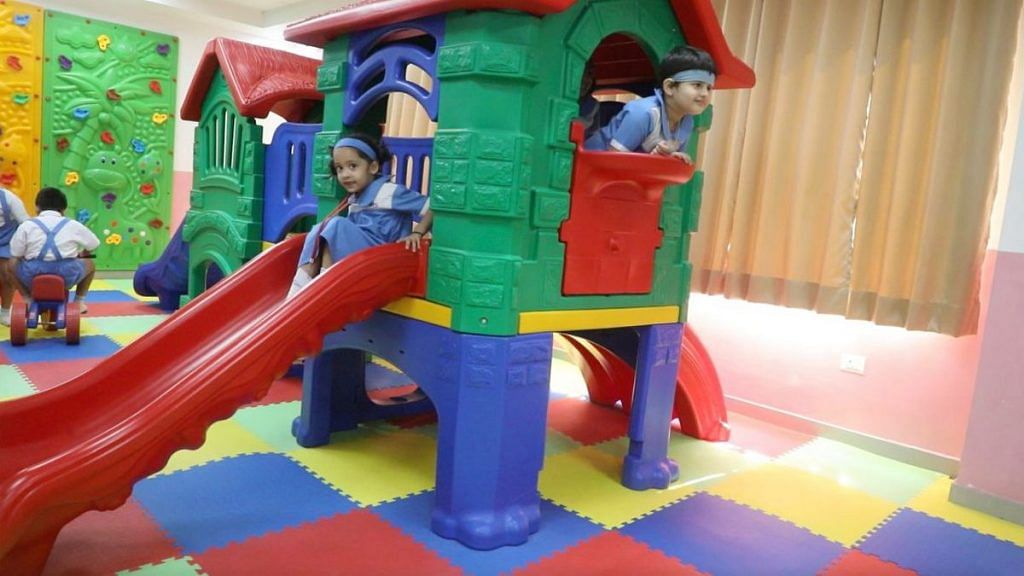
“CMS is setting a template for other schools,” said Prerna Singh, a psychology teacher at Rajajipuram and a CMS alumna. “Earlier, CMSians were mocked for our excessive rote learning. Now, our hands-on education approach intimidates other schools,” she said.
Teachers credit Kingdon for this fresh approach.
“I did pick a few concepts like ‘hands-on education’ and overall personality building from UK schools because my son studied there. I brought those good bits with me to India and tried to implement them at CMS,” Kingdon said.
CMS was the first school in Lucknow to affiliate with the Cambridge Assessment International Education (CAIE) Exam Board. In 2016, Jagdish Gandhi introduced the curriculum in a few branches, and his daughter has continued to expand it since. Today, two CMS branches follow the Cambridge curriculum until Class 8, while three campuses—Gomti Nagar Extension, Rajajipuram I, and Aliganj Campus I—are affiliated with CAIE through Class 12.
But it was difficult to convince parents to switch from ICSE to Cambridge due to the higher fees, said Priya Chhatrawal, a Cambridge educator at the Rajajipuram branch. A Class 9 student enrolled in the ICSE/ISC course pays a monthly composite fee of Rs 10,950, while those in the Cambridge programme pay Rs 18,300.
“Parents were reluctant, of course. We somehow managed to make them take the plunge, and the following year, we had more and more people coming in,” Chhatrawal added.
By all accounts—teachers, journalists, politicians—the late Jagdish Gandhi was driven by the desire to make CMS an international brand. He spoke about the need for a ‘world government’, ‘world peace’ ‘world leaders’ and ‘world unity’. Over the years, the school launched initiatives like Model United Nations, the Chief Justice Conference, the World Peace Prayer, and the World Unity Prayer.
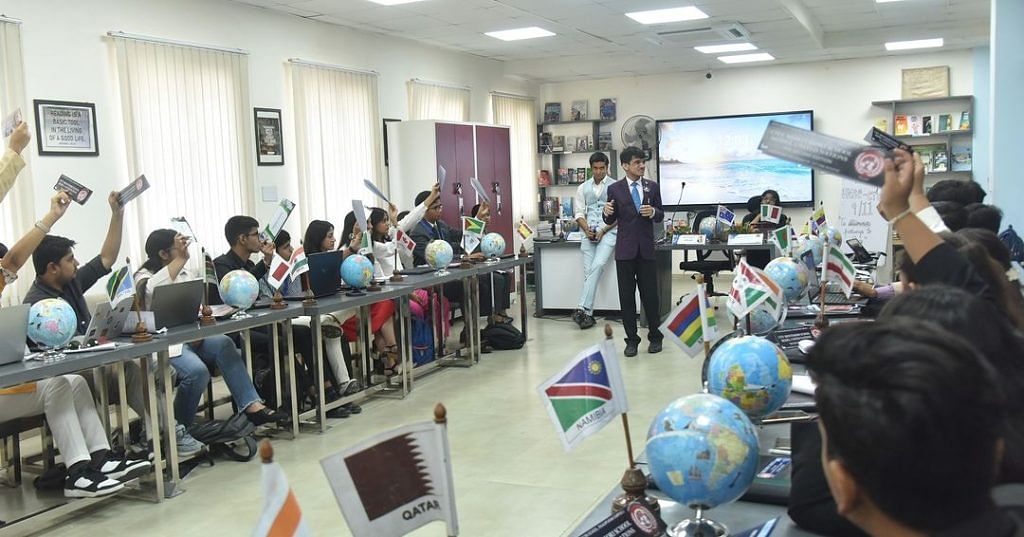
The ‘world’ is now part of the school’s DNA—and echoed by most students.
“Other schools might excel in certain areas, but CMS nurtures future world leaders, not just math or English experts,” said Pankhuri Saxena, a Class 9 student at CMS Rajajipuram.
In the 2023 ISC and ICSE finals, 4,041 of 6,650 CMS students in classes 10 and 12 secured 90-99.75 per cent (aggregate). That year, one of its Class 12 ISC students ranked first in India, and three ranked second.
War of the schools
When CMS started, it had a Herculean challenge ahead. The entire school universe in Lucknow was dominated by four ‘big boys’—La Martiniere Boys, La Martiniere Girls, Loreto Convent, and St Francis. It was a David vs Goliath situation, where the odds were stacked in favour of these four convents. They had pratishtha, parampara, and privilege on their side, while CMS was the new kid on the block, looking to disrupt the established order.
For decades, it was seen as the school that would take anyone who could pay the fees, and wasn’t even considered in the same league.
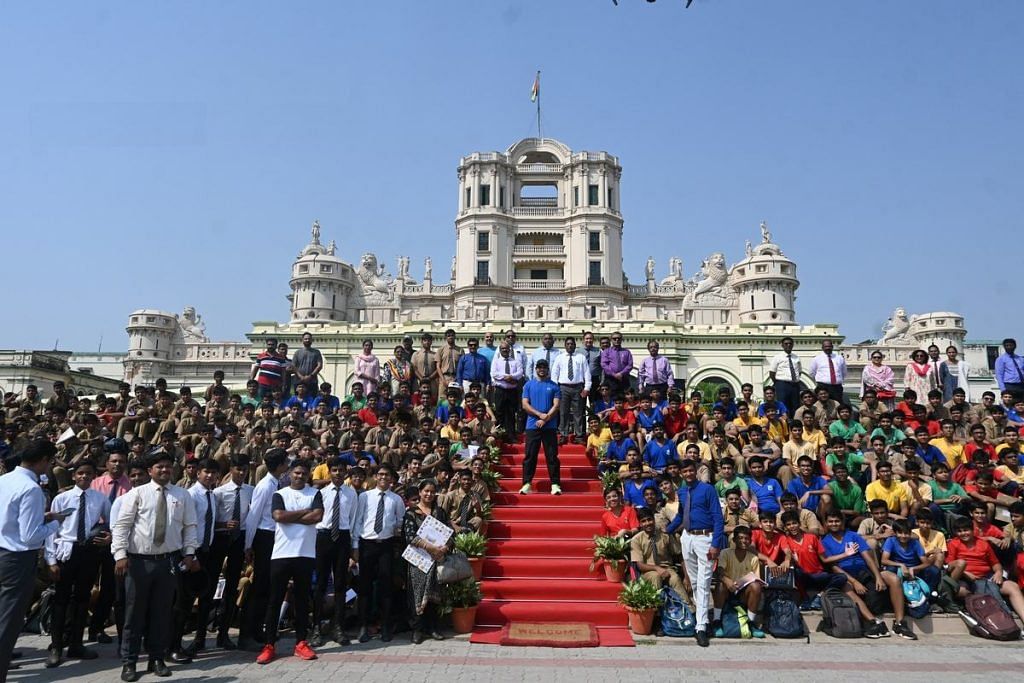
“There was a time when the Big 4 didn’t even consider CMS on their level,” said Kavita M, a 42-year-old Bengaluru-based senior editor who split her childhood between Lucknow and Kenya. “Even I studied in CMS for a year because they’d take everyone, but when my mother finally got me into Loreto in Grade 9, it was like a miracle.”
But CMS was starting to get noticed. Its students were making a mark at inter-school debates, sports meets, and other events.
Despite this, convent students still derided CMS as the “sadi hui moongphali (rotten peanuts) school”.
We focus on IIT-level studies, CMS would counter. They claimed they were younger, more agile and ‘with it’ against the stodgy, inflexible legacy of the elite schools. Their branding was all about ‘being global in Lucknow’.
The brand war between schools in Lucknow was similar to the rivalry between going to St Stephen’s vs Ashoka University today.
Earlier, CMSians were mocked for our excessive rote learning. Now, our hands-on education approach intimidates other schools
-Prerna Singh, psychology teacher at CMS Rajajipuram
However, CMS had something the convents couldn’t compete with—sheer volume.
“Every school has, say, 50 exceptional students. At CMS, that’s 21 x 50, much more than the convents,” Kavita M added.
Over time, CMS began to pull ahead, not just in numbers but in ambition. It became known for hosting lavish international events like the Chief Justices Conference.
While the convents leaned on their legacy, CMS positioned itself as a school for future world leaders.
One former CMS student pointed out that they didn’t need to insult “spoiled brats” from the convents—they knew time was up for those nursing a colonial hangover.
A long climb up
The story of CMS’ humble beginnings has become part of its lore. The world’s largest school was started in 1959 by Jagdish and his wife Bharti Gandhi with just five students—all from one family.
“We went door to door requesting people to send their children. But our lack of credibility left us empty-handed; people would simply shut their doors in our faces,” recalled 88-year-old Bharti Gandhi, seated in her white saree at the CMS head office. An attendant gently massaged her feet with mustard oil.
But within a couple of years, CMS became a full-fledged school with five campuses in Lucknow.
During this time, Gandhi also dipped into politics. In 1969, he won the Vidhan Sabha election as an independent candidate from Sikandra Rao, Aligarh, and served as an MLA for five years before quitting politics.
Initially, CMS operated as a Hindi-medium institution, but a visit to Russia in 1971 convinced the Gandhis that English-medium was the way to go.
“They (the Gandhis) faced challenges communicating due to their lack of fluency in English,” said Kingdon.
A sign reading “Speak only in English” now hangs at the entrance to Bharti Gandhi’s office.
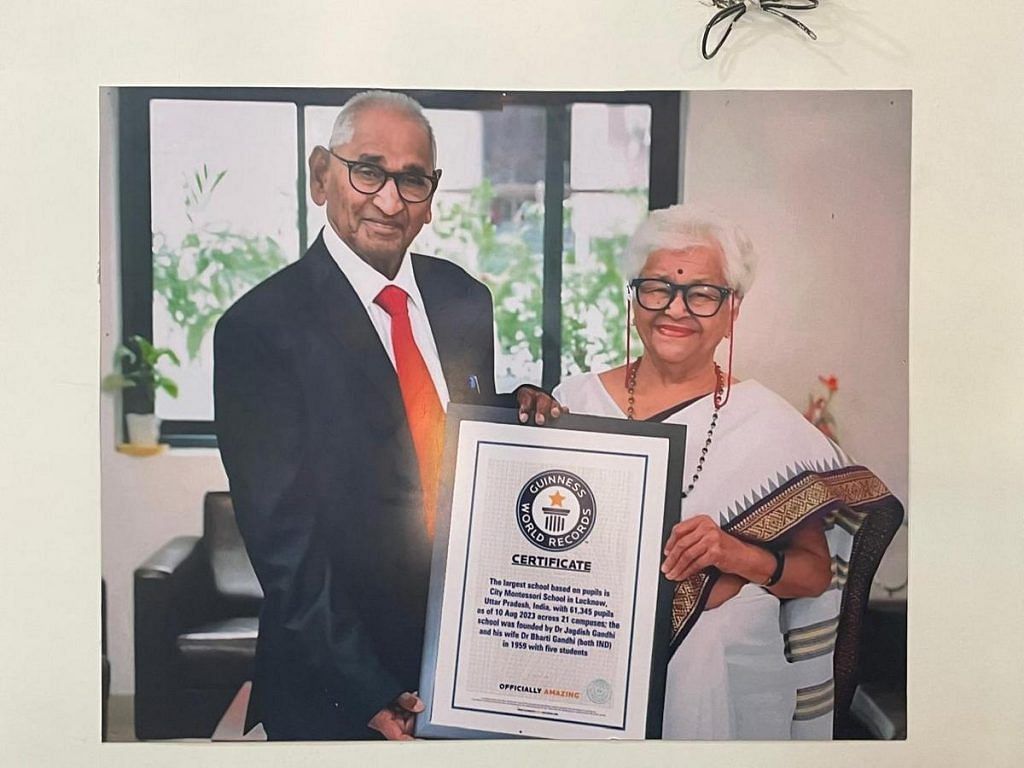
Much of CMS’ ascent is credited to Jagdish Gandhi’s relentless drive. Bharti jokingly called him “guru ghantal” for taking over the teaching himself in the early days. He’d doze off by midnight and wake up by 4 am, often grabbing short naps at the CMS office, where his single bed still stands. He stuck to simple leather slippers, except when abroad to strike deals and collaborations for CMS.
Awards and accolades soon came Gandhi’s way—the Global PIEoneer Award in the UK in 2021, the Excellence Award in 2003 from the Council of Global Education in the USA, and a Lifetime Achievement Award from the Uttar Pradesh government in 2018. The trophies are lined in neat rows in his office, now occupied by Kingdon.
He worked till his very last day, said Bharti.
“My last conversation with him lasted just five minutes. We discussed some education-related reforms, he was rushing for an event,” she recalled. “A few hours later, I received a call saying he wasn’t feeling well, and we rushed him to the hospital.”
He died a few days later on January 24. The doctors said it was a heart attack.
“He died with his boots on,” said Bharti.
While Kingdon is the managing director of CMS, nothing happens without her mother’s signature.
“I will also die working—just like my husband,” Bharti added, pointing to a mountain of files awaiting her signature.
High scores, high ‘pressure’
With more than half of its students scoring 90 per cent in the board exams in recent years, CMS takes academics very seriously.
In the 2023 ISC and ICSE finals, 4,041 of 6,650 CMS students in classes 10 and 12 secured 90-99.75 per cent (aggregate), its website proudly announces. That year, one of its Class 12 ISC students ranked first in India, and three ranked second.
But the intense academic focus has its critics.
“I feel the academic pressure is overwhelming. There are classroom lessons, remedials, extra classes, and heaps of homework — give the child a goddamn break,” said Rakhi Baweja, who shifted from Gorakhpur to Lucknow nine years ago.
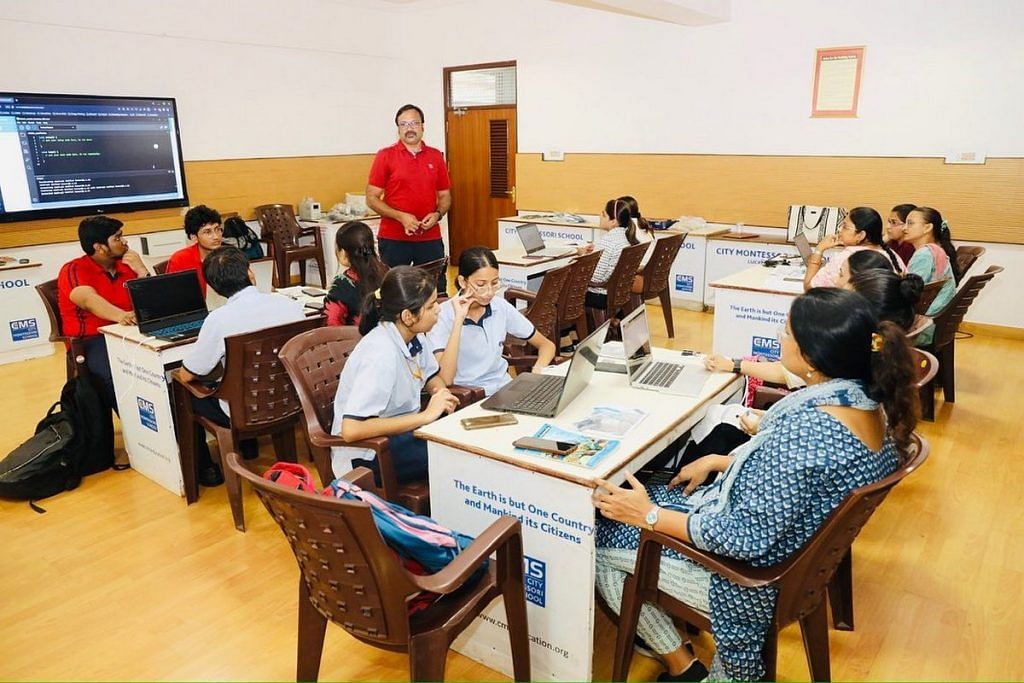
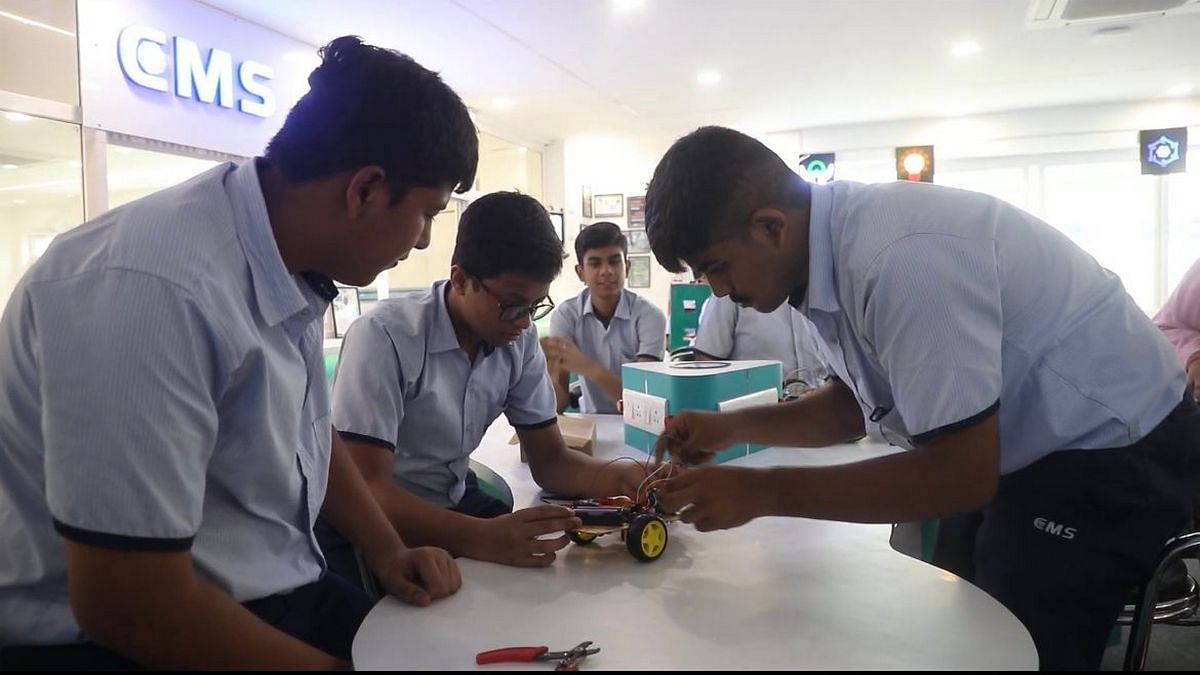
When Baweja was hunting for schools, everyone recommended CMS, but relatives warned her about the academic pressure and she enrolled her sons at St Francis School instead.
“Studying is important, but not to this extreme,” she said, adding that her friends often talk about the pressure on their children at CMS.
This is also what made Anas Elahi break with family tradition. Even though he studied at CMS (1999 batch) and enrolled his elder son Amaan at the Station Road campus, his younger son and daughter attend other schools— Vibgyor High and La Martiniere Girls respectively.
It wasn’t an easy decision for the family.
“CMS was my second home. In today’s time, it’s a safe and secure place. They have a clear policy of respecting all religions,” said Elahi. “But I don’t appreciate CMS’ policy of putting such heavy academic burdens on students and parents. There is no time for co-curricular activities.”
However, students and alumni bristle at claims of academic pressure, instead highlighting CMS’ focus on world peace and spirituality. For Manyata, a class 12 student at CMS Gomti Nagar Extension, this is what makes the school “special”.
The World Unity Prayer is central to this ethos. It features a group of students divided into various religions, each dressed in traditional attire. One by one, they gather at the centre to perform specific gestures while the corresponding religious music plays in the background. The goal is to help students understand and respect all religions.
“While other schools either ignore spirituality or limit it to one religion, CMS stands out with its ‘all religions are one’ philosophy,” said another student.
A pecking order
While all CMS schools are known for rigorous studies, there’s an unspoken hierarchy among the branches. Of the 21 campuses, only Gomti Nagar I, II, and Mahanagar have robotics labs. Just three campuses—Gomti Nagar Extension, Rajajipuram I, and Aliganj I—are affiliated with the Cambridge Assessment International Education (CAIE) Exam Board. Not all have swimming pools.
Santosh Pal, whose daughter is a CMS alumna from Gomti Nagar I, claimed that this branch, Gomti Nagar II, and Rajajipuram offer the best facilities.
“You can see exactly where your money is going, so you don’t mind the high costs. My daughter dreams of flying an aeroplane, and one day she will,” said Pal, who runs his family’s sari shop in Aminabad.
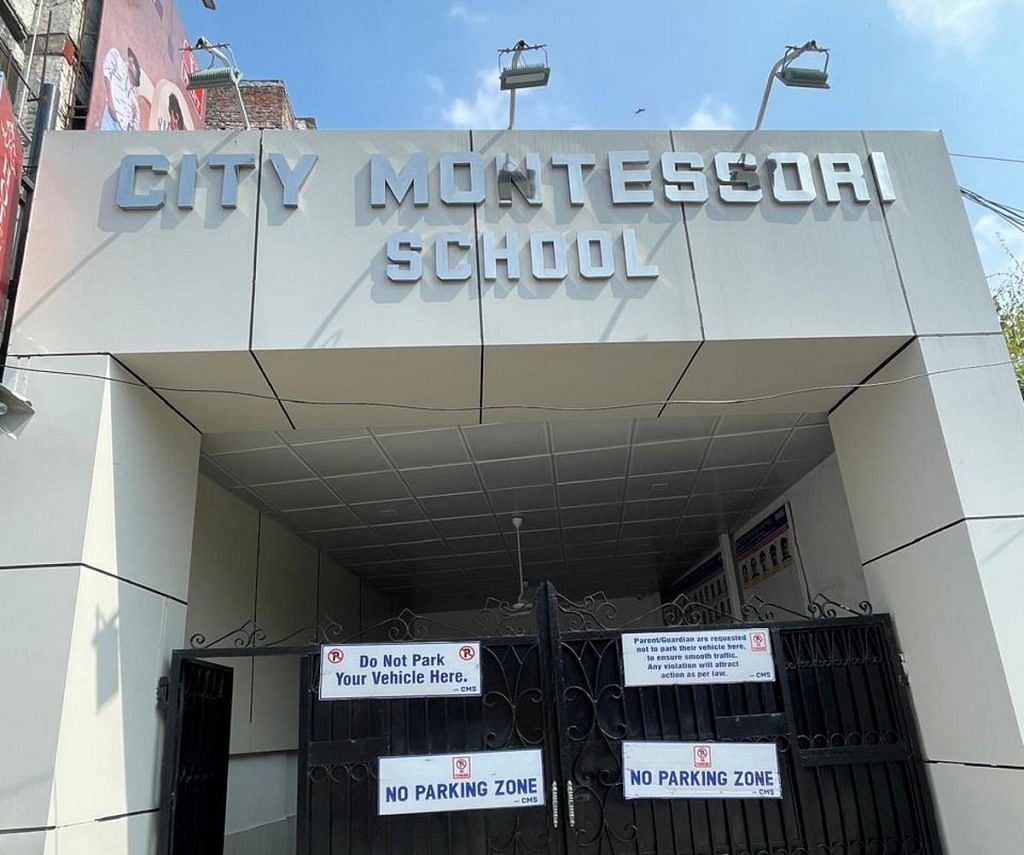
Pal, who attended a government school until Class 10, was willing to invest about Rs 10,000 a month for a school with “top-notch facilities” and exposure. He wasn’t keen on the CMS Station Road campus, the school’s oldest, because it lacks facilities like a swimming pool, robotics lab, and spacious classrooms.
The Aliganj-II, Anand Nagar, and Asharfabad campuses, which only offer education up to Grade 8, are also less popular.
“As a parent, you pick a campus where your child can get maximum returns. And, unfortunately, some campuses are lagging behind,” Pal said.
Also Read: Delhi Amity School students wrote $36bn space dream. NASA took note, gave them a grand prize
Modernising the legacy
The Gandhis are not afraid of change. From Hindi-medium to English to forays into the Cambridge curriculum, there’s a concerted effort to stay on top of changing education trends. Now, students are being trained to code and use artificial intelligence to their advantage.
With so many schools and tens of thousands of students, it’s studiously avoided controversy. Local journalists and politicians have largely good things to say about CMS.
“I witnessed young boys and girls learning coding in the computer. It is something typically taught in colleges, yet CMS introduces these concepts to young minds,” said education minister Sandeep Singh.
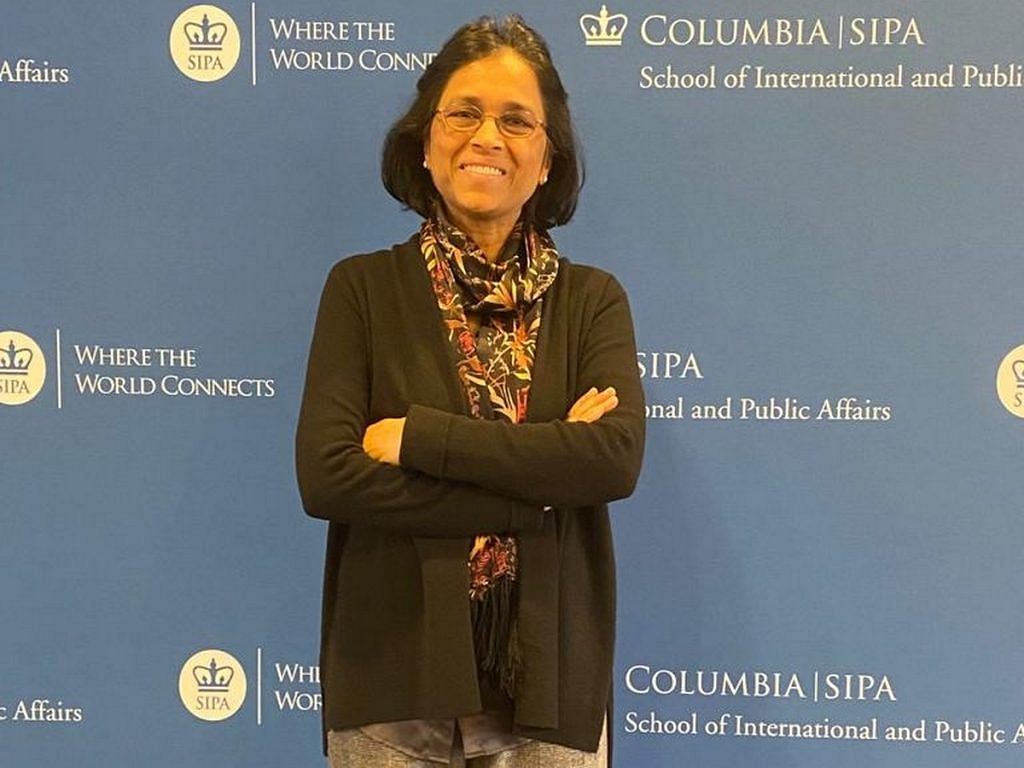
These newer classes are part of the changes led by Geeta Gandhi Kingdon. A part-time professor at University College London, she returned to India in 2007 to help her parents run the school.
For the trained econometrician, it was a steep learning curve.
“It was never on my bingo card,” said Kingdon, who is now working to modernise CMS. If her parents relied on instinct, she prioritises data.
From student performance to administration and transport, everything at the school is data-driven to help track learning outcomes and identify areas for improvement.
“CMS has undergone a significant change in the last five years,” said Station Road principal Deepali Gautam, who has been associated with the school for the last 28 years, including as a student.
“There is a huge shift in the pedagogy in how lessons are imparted and how assessments have to be framed,” she said.
At 8 am, the standard 5 A classroom in the Aliganj-I branch is abuzz with the chatter of around 35 students. But the minute the maths teacher enters, in almost perfect synchrony, the students spring to their feet and chant: “Jai Jagat, Jai Jagat”.
(Edited by Asavari Singh)



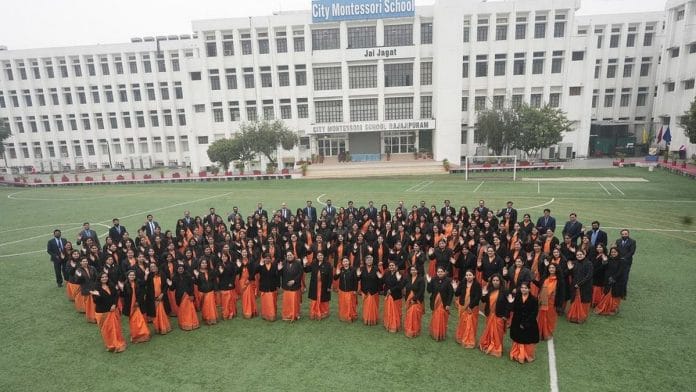



It’s a scam. No more, no less.
My advice to parents would be to stay away from such schools which charge exorbitant fees. The simple and humble Kendriya Vidyalaya (and it’s many other equivalents) or the state hoard school does the job. Students turn out well educated and do well in their careers.
Such elite schools simply sell status and the output is usually a snob.
I am proud of this school, it is the best school in Lucknow and our children are learning something new every day, this is why we have come to know, so many congratulations to all the teachers who work so hard for the children. with.???
I am proud of this school, it is the best school in Lucknow and our children are learning something new every day, this is why we have come to know, so many congratulations to all the teachers who work so hard for the children. with
Inspite of such elite schools, why does U.P. & Bihar lag in all aspects of Indian socio-economical development ?
Then they dont have proper policy for teacher and other staff memebr.
They don’t provide basic things to thier staff, like life insurance, work life balance and more.
looks like the paid article ….
This is not expected from print
Asvari singh has edited written the article
just did the paid promotion of Cms
That’s great news ?️ fantastic ? to see my school ? being famous ???
So proud to be a minuscule part of this magnanimous family .
Excellent school in Lucknow.
Fees of Rs. 11,000/- for the ICSE course? Seriously?
I would advise all parents to avoid such schools. This article keeps repeating “world leaders” and yet I could not find even a single name in the alumni list which deserves that epithet.
The Big Four of Lucknow, referred to here, are just as useless.
These schools are essentially for the elite sections of society – parents who can afford to straightaway send their children to Oxford/Cambridge/Harvard/Yale/etc. right after schooling.
The average middle class Indian simply cannot afford this.